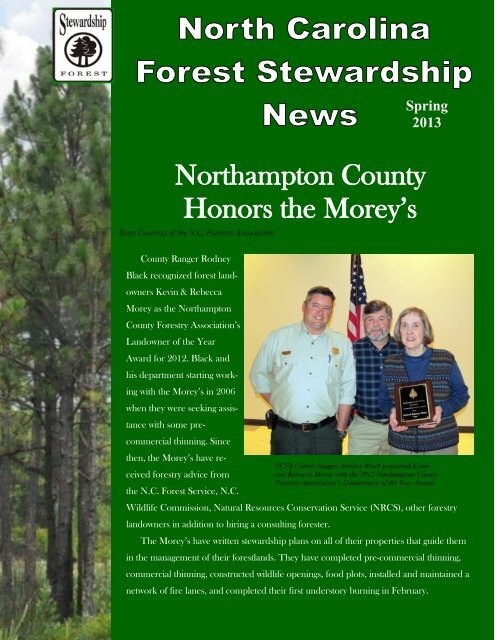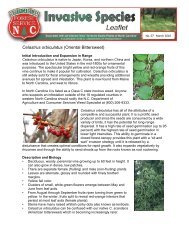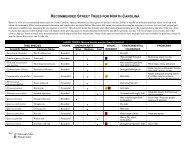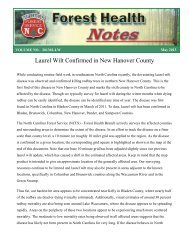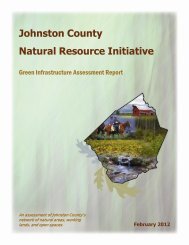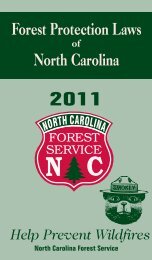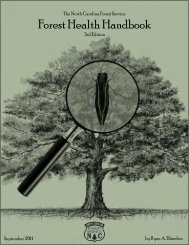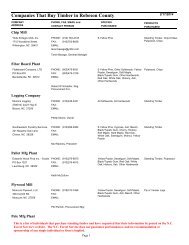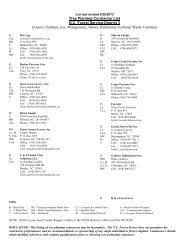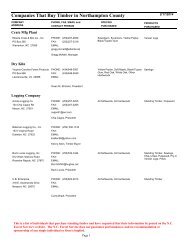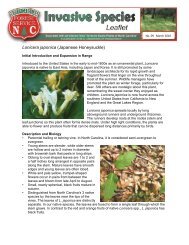Northampton County Honors the Morey's - NC Forest Service
Northampton County Honors the Morey's - NC Forest Service
Northampton County Honors the Morey's - NC Forest Service
- No tags were found...
Create successful ePaper yourself
Turn your PDF publications into a flip-book with our unique Google optimized e-Paper software.
3The North Carolina Tree Farm Program selected Dwight andJudy Batts of Macclesfield, North Carolina as <strong>the</strong> 2012 NorthCarolina Tree Farmers of <strong>the</strong> Year. The Batts have been TreeFarmers since 2002 and extremely active in <strong>the</strong> program.If it were not for his involvement in <strong>the</strong> program’s leadership,Batts probably would have been North Carolina’s Tree Farmer of<strong>the</strong> Year at any point over <strong>the</strong> past 10 years, but Dwight did notwant to be nominated while he was an active member of <strong>the</strong> stateleadership committee.After earning Tree Farm status, Batts began to volunteer histime and talent to <strong>the</strong> North Carolina Tree Farm Program. Battsspent two years as Chair-Elect, three years as Chair and threemore years as Past-Chair on <strong>the</strong> North Carolina Tree Farm’s Executive Committee.While he is no longer involved on <strong>the</strong> state committee, Batts was recruited toserve on <strong>the</strong> National Tree Farm Woodland Committee and is <strong>the</strong> advocacy coordinatorfor <strong>the</strong> North Carolina Tree Farm program, meaning he coordinates communicationsto forestland owners on public policy that is or may impact forest landownersin <strong>the</strong> state.In addition to his work with <strong>the</strong> Tree Farm Program, Batts has served on <strong>the</strong><strong>NC</strong>FA’s Board of Directors for several years as a landowner/Tree Farm representative.He is also an active member of <strong>the</strong> Wilson <strong>County</strong> <strong>Forest</strong>ry Association, havingbeen named Wilson <strong>County</strong>’s Tree Farmer of <strong>the</strong> Year in 2001.Batts, who is retired after a successful career with Abbott Laboratories, is a fourthgeneration farmer/ forestland owner. His Tree Farm totals 350 acres of forestland andis spread over three tracts within a few miles of each o<strong>the</strong>r. Dwight and Judy reside on<strong>the</strong> Batts Farm, which has been in <strong>the</strong> family for over 100 years and totals 160 acres.The Robbins Nest and Long Path Tree Farms comprise <strong>the</strong> rest of <strong>the</strong> forest acreagein <strong>the</strong> Tree Farm.Batts takes an active role in <strong>the</strong> planning and management of his Tree Farm that ishome to pines, assorted hardwoods, and a tremendous variety of wildlife and insects.In fact, he and his family may dedicate almost as much time to <strong>the</strong>ir wildlife management(bee hives, quail and waterfowl enhancement projects, quality deer managementprogram, etc.) as <strong>the</strong>y do on <strong>the</strong>ir trees.Dwight and Judy Batts Named 2012North Carolina Tree Farmers Of The Year
4PeopleWib Owen Retires from <strong>the</strong> N.C. <strong>Forest</strong> <strong>Service</strong>New Leadership announced for <strong>NC</strong>FSWib Owen ended his 34-year career with <strong>the</strong> North Carolina<strong>Forest</strong> <strong>Service</strong> (<strong>NC</strong>FS) and North Carolina Wildlife ResourcesCommission in front of family, friends and co-workersat <strong>the</strong> North Carolina State Fairgrounds. The luncheon celebratedWib's achievements over <strong>the</strong> years and his dedicatedservice.North Carolina Commissioner of Agriculture, Steve Troxler,presented Owen with <strong>the</strong> Order of <strong>the</strong> Long Leaf Pine,which is one of <strong>the</strong> state's highest honors. The Order of <strong>the</strong>Long Leaf Pine is presented to individuals who have a provenrecord of extraordinary service to <strong>the</strong> state.The N.C. <strong>Forest</strong>ry Association (<strong>NC</strong>FA) and <strong>the</strong> NorthCarolina <strong>Forest</strong> <strong>Service</strong> have historically pooled <strong>the</strong>ir respectiveresources in terms of staff time, money and elbow grease toachieve favorable results for forestry and forest landowners in our state.When Wib Owen became <strong>the</strong> new state forester, he certainly embraced this traditionand worked hand-in-hand with <strong>the</strong> <strong>NC</strong>FA on countless projects. The biggestproject was <strong>the</strong> transfer of <strong>the</strong> <strong>Forest</strong> <strong>Service</strong> over to <strong>the</strong> North Carolina Departmentof Agriculture, which most agree, has been a great thing for <strong>the</strong> <strong>NC</strong>FS and forestryin North Carolina.Wib has been a true ally over <strong>the</strong> years and <strong>the</strong> <strong>NC</strong>FA looks forward to workingwith him in <strong>the</strong> future in his new role as <strong>the</strong> Executive Director for <strong>the</strong> Sou<strong>the</strong>rnN.C. State <strong>Forest</strong>er Greg PateGroup of State <strong>Forest</strong>ers.On <strong>the</strong> heels of Wib Owen's retirement, two newleaders have emerged to oversee and direct <strong>the</strong><strong>NC</strong>FS.Scott Bissette, who has been with <strong>the</strong> North Carolina Department of Agriculture for<strong>the</strong> past 16 years, has been chosen to lead <strong>the</strong> <strong>NC</strong>FS as Assistant Commissioner.He formerly served as <strong>the</strong> Agricultural Programs Administrator.Greg Pate, who was <strong>the</strong> Deputy State <strong>Forest</strong>er under Owen, has been named NorthCarolina's new State <strong>Forest</strong>er.Wib Owen Receives <strong>the</strong> Order of The Longleaf Pine fromCommissioner Steve TroxlerAssistant Commissioner Scott Bissette
5HOLMAN NAMED NORTH CAROLINASTATE DIRECTORFOR THE CONSERVATION FUNDCHAPEL HILL, N. C. (Dec. 3, 2012) – The Conservation Fund has named BillHolman as director of its North Carolina office, effective January 2, 2013. Holmanstepped down as director of State Policy at Duke University’s Nicholas Institute forEnvironmental Policy Solutions to join <strong>the</strong> Fund.“I have had a passion for conservation since family and Boy Scout camping trips to <strong>the</strong> Outer Banks, GreatSmokies, Blue Ridge Parkway, and Raven Knob,” Holman said. “Land and water conservation is critical to NorthCarolina’s economy and environment. I’m excited about <strong>the</strong> opportunity to apply <strong>the</strong> knowledge that I’ve acquired atDuke University to help The Conservation Fund and its many partners sustain North Carolina’s economy and conserveits natural resources.”Holman will lead <strong>the</strong> Fund’s efforts to advance land and water conservation across North Carolina. Over <strong>the</strong> past28 years, <strong>the</strong> Fund has conserved more than 200,000 acres in <strong>the</strong> state, protecting icons such as Grandfa<strong>the</strong>r Mountainand Chimney Rock state parks, DuPont State Recreational <strong>Forest</strong>, Lake Logan, Palmetto Peartree Preserve and PocosinLakes National Wildlife Refuge. Much of this work has been led by Senior Associate Dick Ludington, whose realestate efforts at <strong>the</strong> Fund continue. The organization’s work in North Carolina also includes long-standing communityand economic development efforts.“Bill has been a champion for conservation across North Carolina, and we’re thrilled that he’s joining The ConservationFund as it works with willing sellers to protect land and pursues conservation-oriented economic development,”said R. Michael Leonard, vice chairman of The Board of Directors of The Conservation Fund and an attorney withWomble Carlyle Sandridge & Rice. The Conservation Fund President and CEO Larry Selzer added, “Bill’s breadth ofexperience, creative approach to integrating environmental and economic goals, and ability to work with people fromevery sector make him an ideal leader for our North Carolina work in <strong>the</strong> years ahead.”At Duke, Holman collaborated with <strong>the</strong> City of Raleigh and local land trusts on <strong>the</strong>ir innovative Upper NeuseClean Water Initiative, where <strong>the</strong> city’s water customers conserve important lands in <strong>the</strong> Falls Lake watershed.Holman previously served as Governor Jim Hunt’s secretary of <strong>the</strong> Department of Environment and Natural Resourcesand as executive director of <strong>the</strong> N.C. Clean Water Management Trust Fund.“Bill has been an invaluable member of <strong>the</strong> Nicholas Institute family from <strong>the</strong> beginning, and he has helped build<strong>the</strong> Institute into a trusted resource in <strong>the</strong> state energy and environmental debates,” said Tim Profeta, Director ofDuke’s Nicholas Institute for Environmental Policy Solutions. “We will miss Bill’s infectious enthusiasm and tremendouswisdom on a daily basis, but know that he will remain part of our work and conversations from his new role.”A top-ranked national nonprofit, The Conservation Fund combines a passion for conservation with an entrepreneurialspirit, understanding that lasting conservation solutions must make environmental and economic sense. Since(Continued on page 6)
6(Holman—continued from page 5)1985, <strong>the</strong> Fund has helped community, government and business leaders protect more than seven million acres of highpriorityconservation lands nationwide, including wildlife habitat, working farms and forests, community green space andhistoric sites.Many of The Conservation Fund’s national programs are based in Chapel Hill, including <strong>the</strong> Natural Capital InvestmentFund, Resourceful Communities, Shade Fund, and Strategic Conservation. The <strong>NC</strong> office is <strong>the</strong> Fund’s largestoffice outside of its Arlington, VA headquarters.McNulty Named “Most Distinguished” in <strong>Forest</strong> SciencePosted by zhoyle on February 4, 2013Dr. Steven McNulty, research ecologist with <strong>the</strong> U.S. <strong>Forest</strong> <strong>Service</strong> Sou<strong>the</strong>rn ResearchStation (SRS), recently received <strong>the</strong> agency’s national Research and Development“Distinguished Science Award.” He is recognized for sustained research productivity,proactive science technology, innovative leadership, applied forest science, andlongtime federal service. McNulty accepted his award during <strong>the</strong> February 12, 2013,ceremony in Arlington, VA.“I’m deeply honored to receive <strong>the</strong> <strong>Forest</strong> <strong>Service</strong> distinguished science award,”says McNulty, a 21-year career scientist based in Raleigh, <strong>NC</strong>, who has written morethan 150 scientific papers and given hundreds of scientific presentations.“<strong>Forest</strong> science positively impacts some of society’s most significant environmentalissues that impact citizens right here in Raleigh, including climate change, water supply,and timber production. I value collaborating with a team of public, private, anduniversity partners who are on <strong>the</strong> cutting-edge of science exploration and discovery.”McNulty’s individual research focuses on continental-scale forest water, productivity, and health modeling, wi<strong>the</strong>mphasis given to interactions and response of forests to global climate change, acid rain, and o<strong>the</strong>r environmentalstresses. A North Carolina State University USDA Professor of Natural Resources, McNulty also serves as an adjunctprofessor at <strong>the</strong> University of Toledo (Ohio) and Beijing <strong>Forest</strong>ry University (China).McNulty received forest and natural resources degrees from <strong>the</strong> University of Wisconsin – Madison, and a PhD innatural resources from <strong>the</strong> University of New Hampshire, under <strong>the</strong> direction of renowned scientist Dr. JohnAber. He leads a dynamic research team within <strong>the</strong> SRS Eastern <strong>Forest</strong> Environmental Threat Assessment Center,located on North Carolina State University’s Centennial Campus. An internationally recognized expert on climatechange issues, McNulty spearheads development of research and tools designed to help land managers better understandand cope with climate change impacts on forest management. –Perdita SpriggsFor additional information: Dr. Steven McNulty at (919) 515-9489 or smcnulty@fs.fed.us
7Schaefer Introduced as N.C. <strong>Forest</strong>ry Association'sNew Executive Vice PresidentNewly appointed N.C. <strong>Forest</strong>ry Association's (<strong>NC</strong>FA) Chairman of <strong>the</strong>Board Ashley Faircloth announced in <strong>the</strong> new business section of <strong>the</strong>irBoard of Directors Meeting that Bob Schaefer has been chosen among<strong>the</strong> talented pool of 20 candidates who applied for <strong>the</strong> position as <strong>the</strong> nextExecutive Vice President of <strong>the</strong> organization."We are pleased to announce Bob Schaefer as our new Executive VicePresident," stated Faircloth. "Bob has a great understanding of our associationas a past president, and his management experience and forestproducts background will be a tremendous plus for our association as wemove forward."Schaefer, a past <strong>NC</strong>FA President, had been working with <strong>the</strong> association as a contract employeethrough <strong>the</strong> Sentinel <strong>Forest</strong> Project. A graduate of <strong>the</strong> University of Kentucky with a bachelor's degree in<strong>Forest</strong>ry, Schaefer has over 25 years in <strong>the</strong> forest products industry with Weyerhaeuser and Williamette.In addition to his years on <strong>the</strong> <strong>NC</strong>FA's Executive Committee, Schaefer has been active on several<strong>NC</strong>FA committees. He also has been strong supporter of <strong>the</strong> Friends of <strong>Forest</strong>ry Political Action Committee.O<strong>the</strong>r action items in <strong>the</strong> Board Meetingwere <strong>the</strong> confirmation of <strong>the</strong> 2013 ExecutiveCommittee, <strong>the</strong> 2013 Board of Directors,and <strong>the</strong> approval of a 2013 operatingbudget for <strong>the</strong> association.The 2013 Board of Directors includeselected members as well as one-year appointmentsand leaders of respective partneragencies/associations.The Board also approved <strong>the</strong> operation budget for <strong>the</strong> association. The approved budget includes adeficit that will be covered by reserve funds accumulated over <strong>the</strong> past years. It is important to note that<strong>the</strong> budget includes several non-recurring expenditures such as database development and website improvements.The strategic planning group recommended <strong>the</strong> <strong>NC</strong>FA move quickly on <strong>the</strong> upgrading <strong>the</strong>association's technology. The goal is to return <strong>the</strong> <strong>NC</strong>FA to a "balanced budget" in 2014.Bob Schaefer2013 Executive Board of <strong>the</strong> <strong>NC</strong>FA Chairman of <strong>the</strong> Board: Ashley Faircloth President: Allen Plaster President/elect and Treasurer: Ray Allen First Vice President: Frank Rackley Eastern Vice President: Jim Durham Piedmont Vice President: Bernard Rose Western Vice President: Fred Hardin Executive Vice President: Bob Schaefer <strong>Forest</strong>ry Mutual Insurance Co.: Sen. Michael Walters
8Wildlife Resources Commission Biologist Wins AwardRALEIGH, N.C. (Nov. 7, 2012) — Bennett Wynne, a fisheries biologistwith <strong>the</strong> N.C. Wildlife Resources Commission, was named Fisheries Biologistof <strong>the</strong> Year by <strong>the</strong> Sou<strong>the</strong>astern Association of Fish and Wildlife Agencies at its66 th annual conference on Oct. 9, 2012 in Hot Springs, AR.Wynne received <strong>the</strong> honor for his outstanding work in both aquatic habitatconservation and fisheries management. As <strong>the</strong> agency’s Anadromous FisheriesCoordinator, Wynne coordinates <strong>the</strong> management of coastal migratorystocks of shad, herring, striped bass and Atlantic sturgeon. He has developedcritical working relationships with numerous stakeholders concerning enhancement of aquatic habitats for <strong>the</strong> benefit of<strong>the</strong>se populations.“Bennett works diligently to assure adequate spawning flows for migratory fish in North Carolina’s coastal rivers,continually looking for opportunities to increase access to upstream habitats,” said Robert Curry, chief of <strong>the</strong> Division ofInland Fisheries.On <strong>the</strong> Cape Fear River, Wynne advocated for years in support of construction of a rock arch fish passageway overLock and Dam 1 — <strong>the</strong> first impediment to anadromous fishes migrating upriver from <strong>the</strong> ocean. Beginning June 1,2011, <strong>the</strong> U.S. Army Corps of Engineers began construction of a rock arch fish passageway at this location, and <strong>the</strong> projectis now almost complete.“This is a landmark accomplishment, representing <strong>the</strong> first rock arch structure for fish passage built in North Carolina,and one of only a few in <strong>the</strong> Sou<strong>the</strong>ast,” Curry said.Wynne is currently involved with evaluating <strong>the</strong> effectiveness of this structure and will help determine <strong>the</strong> potentialfor similar passage projects on dams upstream.In 2010, he coordinated Atlantic sturgeon sampling in <strong>the</strong> upper Roanoke River basin, which resulted in <strong>the</strong> firstdocumented capture of sturgeon from this area. Currently, he is leading <strong>the</strong> effort to develop plans to enhance river herringstocks in <strong>the</strong> Chowan River basin.“Bennett fills a unique niche, seamlessly blending habitat conservation with fisheries management,” Curry said. “Hiscontributions to anadromous fish population restoration in North Carolina are extensive and make him well deservingof receiving an honor as prestigious as <strong>the</strong> Sou<strong>the</strong>astern Association of Fish and Wildlife Agencies’ Fisheries Biologistof <strong>the</strong> Year.”The Sou<strong>the</strong>astern Association of Fish and Wildlife Agencies is an organization whose members include <strong>the</strong> N.C.Wildlife Resources Commission and state agencies with primary responsibility for management and protection of <strong>the</strong>fish and wildlife resources in 14 o<strong>the</strong>r states, Puerto Rico and <strong>the</strong> U.S. Virgin Islands.For more information on <strong>the</strong> Sou<strong>the</strong>astern Association of Fish and Wildlife Agencies visit http://www.seafwa.org/index.php. To learn more about fishing in public, inland waters, visit <strong>the</strong> fishing page at http://www.ncwildlife.org/fishing.Bennett Wynne holds an Atlantic sturgeon,collected from Weldon in 2010.
9N.C. <strong>Forest</strong> <strong>Service</strong> Employee’s of <strong>the</strong> MonthThe N.C. <strong>Forest</strong> <strong>Service</strong> (<strong>NC</strong>FS) has had a number of “Employee of <strong>the</strong> Month” winners since joining <strong>the</strong> N.C.Department of Agriculture and Consumer <strong>Service</strong>s (<strong>NC</strong>DA&CS). A couple of <strong>the</strong> most recent winners include PamHammond, Office Manager, for and Michael “Turbo” Carlisle, <strong>Forest</strong> Fire Equipment Operator (FFEO).Pam Hammond—Office Manager—January 2013Pam performs all of her job functions with a helpful and positive attitude. She demonstrates amazing initiative on adaily basis. Her spirit and attitude towards her job permeates <strong>the</strong> entire district office and makes it a better place towork while providing <strong>the</strong> citizens of North Carolina outstanding customer service with integrity. Pam shows her commitmentto people in that she is <strong>the</strong> sole person in <strong>the</strong> district that provides administrative support in <strong>the</strong> areas of workerscompensation, benefits and pay issues. Pam excels beyond expectations and demonstrates excellence in customerservice by supplying all personnel with whatever support is needed. If Pam does not know <strong>the</strong> answer she will find <strong>the</strong>answer to provide for <strong>the</strong> needs of <strong>the</strong> employee. Pam speaks fluent BEACON, <strong>the</strong> state online payroll system, and isoften tasked with unraveling some employees pay statement mysteries. Pam demonstrates excellent initiative and veryoften completes tasks before she is even asked to do so. Pam assists in coordinating <strong>the</strong> retirement celebrations for retiringemployees; this includes selection of <strong>the</strong> venue, menu planning and compilation of <strong>the</strong> program.Pam also provides excellent customer service to <strong>the</strong> public by serving as <strong>the</strong> main point contact for <strong>the</strong> public in<strong>the</strong> absence of <strong>the</strong> office clerk.Pam is dedicated to accomplishment in that she is responsible for preparing and disseminating <strong>the</strong> annual budgetproposals that must be voted on by <strong>the</strong> <strong>County</strong> Commissioners for each of <strong>the</strong> eight counties and <strong>the</strong> Jordan LakeEducational State <strong>Forest</strong> in District 3, located in <strong>the</strong> sou<strong>the</strong>rn part of <strong>the</strong> Piedmont with its office in Rockingham. Pamalso oversees not only <strong>the</strong> payroll issues but <strong>the</strong> billing questions in <strong>the</strong> district with a combined budget in excess $2million. This includes <strong>the</strong> myriad of questions encountered as <strong>the</strong> <strong>Forest</strong> <strong>Service</strong> transitioned from Department of Environmentand Natural Resources to <strong>NC</strong>AG&CS.Pam demonstrates enthusiasm for <strong>the</strong> work performed by <strong>the</strong> <strong>Forest</strong> <strong>Service</strong> and is always happy to help out inwhatever is asked of her. Pam recently displayed this characteristic as well as a spirit of volunteerism by serving as partof a N.C. <strong>Forest</strong> <strong>Service</strong> Incident Management Team assisting on <strong>the</strong> Simmons Road Fire in Bladen <strong>County</strong>. Pam alsoassisted and participated in an American Red Cross Blood Drive held at <strong>the</strong> district office.Michael “Turbo” Carlisle—<strong>Forest</strong> Fire Equipment Operator—October 2012Turbo is a 21 year veteran of <strong>the</strong> N.C. <strong>Forest</strong> <strong>Service</strong> as a forest fire equipment operator. He has always excelledin his primary job duties, making sure that everything he does is to <strong>the</strong> level of absolute perfection. His assignedequipment is always neat, clean and organized. He keeps it washed, waxed and repaints it on regular intervals to keepit looking new. Every day, Turbo shows up for work with a starched and pressed shirt and shiny shoes, representingnot only himself, but <strong>NC</strong>FS and <strong>NC</strong>DA&CS in <strong>the</strong> highest of professional regard. Turbo is recognized for his abilitiesby being one of <strong>the</strong> longest reining members of <strong>the</strong> <strong>NC</strong>FS District 8 Pre Arrange Tractor Plow Strike Team, a groupmade up of <strong>the</strong> best of <strong>the</strong> best in wildland firefighting with Tractor Plows. District 8 is in <strong>the</strong> sou<strong>the</strong>astern part of <strong>the</strong>(Continued on page 10)
10(Continued from page 9)state and consists of six counties including Pender <strong>County</strong> where Turbo works out of. Turbo goes far above and beyondhis assigned duties by volunteering to be on several state committees including <strong>the</strong> <strong>NC</strong>FS uniform committee, <strong>the</strong> Region1, coastal, initial attack committees, Tractor and Plow Safety rewrite committee and <strong>the</strong> <strong>NC</strong>FS honor guard. Servingon <strong>the</strong>se types of committees is a rarity among FFEOs. In addition, Turbo is a great instructor, and utilizes his skills voluntarilyto participate as cadre at several schools annually, including: Region 1 fire school; Mountain Truck DrivingSchool; CPR; Forklift Certification; Basic FFEO; Advanced FFEO; Region 1 Strategy and Tactics; and o<strong>the</strong>rs on occasion.He also teaches several introduction to wildland firefighting courses, along with wildland fire suppression to localvolunteer fire departments annually. In addition to <strong>the</strong> many schools he helps to teach, Turbo utilizes his teaching skillsto mentor young FFEOs, providing <strong>the</strong>m with valuable knowledge and insight to help <strong>the</strong>m learn how to do <strong>the</strong>ir jobeffectively and safely.Outside of <strong>the</strong> <strong>Forest</strong> <strong>Service</strong>, Turbo serves as a Battalion Chief on <strong>the</strong> Burgaw Fire Department, where he uses histeaching skills to train and develop young fire fighters. He helps to organize various fund raisers and recognition eventssuch as <strong>the</strong> annual Pender <strong>County</strong> firemen’s appreciation day throughout each year. He is a certified EMT and althoughhe receives no additional pay for maintaining or using this qualification in his job, he readily takes <strong>the</strong> lead inmedical response on <strong>the</strong> job when needed. Turbo keeps a full EMT medical kit and AED with him at all times, includingwhen he is plowing fires with <strong>the</strong> tractor plow. Having this level of emergency medical care available is a piece ofmind to <strong>the</strong> firefighters around him that is rare in our profession. Turbo is a unique individual that finds no task toomenial or too challenging. He simply takes it all in with a smile, a laugh, and lifts those up around him to want to performbetter. His focus is to do <strong>the</strong> very best he can each and every day to help those around him, in his community andin <strong>the</strong> work place.Upcoming EventsWorking Toge<strong>the</strong>r for Longleaf and Prescribed Fire: August 27-28, 2013—Wilmington, <strong>NC</strong>.This workshop is sponsored by <strong>the</strong> <strong>NC</strong> Prescribed Fire Council and <strong>the</strong> <strong>NC</strong> Longleaf Coalition.2013 Mid-Atlantic Logging & Biomass Expo: September 20-21, 2013—Smithfield-Selma Areahttp://www.ncforestry.org/WEBPAGES/PROLOGGER/LOGDEMO/LOGDEMO.htm2013 <strong>NC</strong>FA Annual Meeting: October 2-4, 2013—Doubltree Hilton Riverfront in New Bern.The room rate for <strong>NC</strong>FA members is $139.http://www.ncforestry.org/WEBPAGES/MEMBERSECTION/MEMBERSHIPINDEX.htmWilkes-Yadkin <strong>County</strong> Area <strong>Forest</strong>ry Tour: May 3, 9:30 a.m. to 4 p.m.—Yadkin <strong>County</strong>Presented by <strong>the</strong> <strong>NC</strong> Tree Farm Program in cooperation with <strong>the</strong> North Carolina <strong>Forest</strong> <strong>Service</strong>, <strong>Forest</strong>ry MutualInsurance, Louisiana-Pacific Corporation, and Weyerhaeuser. It will be held in <strong>the</strong> Windsor Crossroads CommunityBuildinghttp://ncforestservice.gov/Hot%20Topics/WilkesYadkinWorkshopFlyer.pdf
11Taxes and Estate PlanningHelp for <strong>Forest</strong> Landowners: Estate PlanningPosted by zhoyle on December 6, 2012Family forest owners may use consulting foresters or State extensionforesters for advice on <strong>the</strong> technical details of land management,but many owners shy away from thinking about how best to pass <strong>the</strong>irforest on to <strong>the</strong> next generation. Poor estate planning–or no planningat all–can result in a tax bill that requires selling timber or forest land,which in turn can lead to subdivision and development.Estate Planning for <strong>Forest</strong> Landowners, a Sou<strong>the</strong>rn Research Station(SRS) publication, provides a comprehensive guide to estate planningspecifically designed for forest landowners.“Over <strong>the</strong> past decade, demographic, social, and market trendshave converged to increase <strong>the</strong> effects of <strong>the</strong> Federal estate tax on rurallandowners.” says John Greene, research forester with <strong>the</strong> SRS<strong>Forest</strong> Economics and Policy unit based in Research Triangle Park,North Carolina. ”Although <strong>the</strong> minimum estate value for paying taxmay seem high, family forest owners, farmers, and ranchers remainMost of <strong>the</strong> forested land in <strong>the</strong> South is owned byfamilies and private individuals. Photo by U.S. <strong>Forest</strong><strong>Service</strong>.many times more likely than <strong>the</strong> U.S. population in general to incur<strong>the</strong> estate tax.”“Besides,” Greene adds, “<strong>the</strong> guide is about estate planning, not just <strong>the</strong> estate tax. As well as describing how touse <strong>the</strong> available tax provisions to minimize or avoid <strong>the</strong> Federal estate tax, it discusses strategies and tools to interestyounger family members in keeping <strong>the</strong> forest intact and train <strong>the</strong>m in how to manage it for <strong>the</strong> values <strong>the</strong> family holdsfor it.”Greene and coauthors William Siegel and Harry Haney designed Estate Planning for <strong>Forest</strong> Landowners to providespecific guidelines and assistance on applying estate planning to forest properties. The guide, which is availablefree of charge from SRS, is designed for use by both private landowners and advisers—legal, financial, insurance, andforestry professionals—who help <strong>the</strong>m with estate planning. The guide presents a working knowledge of <strong>the</strong> Federalestate and gift tax law as it relates to forest properties.Access Estate Planning for <strong>Forest</strong> Landowners.For more information, email John Greene at jgreene01@fs.fed.us
12Timber Tax Sources Available for <strong>Forest</strong> LandownersThe National Timber Tax Website - http://timbertax.org - Is sponsored by <strong>the</strong> USDA <strong>Forest</strong> <strong>Service</strong> and managedby <strong>the</strong> University of Georgia's Center for <strong>Forest</strong> Business. It contains valuable information and links to timbertax information including federal, estate and state tax law websites. It also has a section on new developmentswith links to new publications, workshops, related sources of information and a whole lot more. Dr. Linda Wang,Timber Tax Specialist with <strong>the</strong> <strong>Forest</strong> <strong>Service</strong> is responsible for <strong>the</strong> content.NWOA Timber Tax Website - http://timbertax.com - Is maintained and managed by <strong>the</strong> National WoodlandOwners Association. It has valuable links to service providers and state Extension <strong>Service</strong>s and o<strong>the</strong>r course sponsors.Federal Income Tax on Timber: A Quick Guide for Woodland Owners, 4th Edition, 2012 - FS-1007 - Click herefor link to an online pdf file.Tax Tips for <strong>Forest</strong> Landowners for <strong>the</strong> 2012 Tax Year - Management Bulletin R8-MB 141. Click here for linkto an online pdf file.In addition, <strong>the</strong> forestry webinars portal (http://forestrywebinars.net) hosted a live webinar on timber taxes recently.The archived version can be accessed at any time by following <strong>the</strong> prompts on <strong>the</strong> website to search forpast webinars. Make sure you search for <strong>the</strong> webinar entitled "Income Tax on Timber for Your 2012 Tax ReturnFiling".WildlifeTear Down <strong>the</strong> WallThe Pressure is OnThe U.S. Department of Agriculture's Josh Bieseckeruses a high pressure water system to break through abeaver dam in Orange <strong>County</strong>. Within 10 minutes, Bieseckercut a large whole that allowed <strong>the</strong> water thatwas building towards <strong>the</strong> road drain down <strong>the</strong> onceblocked stream. The Beaver Management Program AssistanceProgram (BMAP) successfully recovers acreageflooded by beaver dams for private landowners, <strong>the</strong>North Carolina Department of Transportation and localmunicipalities. To learn more about North Carolina’sBeaver Management Program contact <strong>the</strong> USDA Wildlife<strong>Service</strong>s at 866-487-3297 or call <strong>the</strong> N.C. Wildlife ResourceCommission at 919-707-0050.
13Cave Climates and White-Nose SyndromePosted by zhoyle on February 28, 2013White-nose syndrome, caused by <strong>the</strong> fungusGeomyces destructans, has decimated bat populationsthroughout eastern North America. Recentestimates show that 6 to 7 million bats have succumbedto white-nose syndrome.This fungus thrives in <strong>the</strong> cool, moist conditionsfound in many caves and mines where batsmay also hibernate. Roger W. Perry, a researchwildlife biologist with U.S. <strong>Forest</strong> <strong>Service</strong> Sou<strong>the</strong>rn Pine Ecology unit recently published an updated review of bat hibernationand cave climates in <strong>the</strong> journal Environmental Reviews to aid managers and researchers working to addressthis disease.“The emergence of white-nose syndrome refocused interest on <strong>the</strong> physical factors that influence cave climates andhow cave climates could potentially interact with growth of <strong>the</strong> fungus and affect bat survival,” explains Perry. “I wantedto understand why caves just a short distance apart may potentially differ in white-nose syndrome infection and mortalityand how <strong>the</strong> climate in a cave could influence fungal growth.”Several different species of bats spend <strong>the</strong> winter in underground shelters. To survive on <strong>the</strong>ir limited fat reservesduring winter, bats generally hibernate in structures that provide temperatures between 4 and 10 o C (39-50 o F). Cavesand mines often provide <strong>the</strong>se cool but above-freezing air temperatures. The high humidity in <strong>the</strong>se underground sheltersalso helps reduce water loss in bats during hibernation.Various factors can reduce or increase cave temperatures and result in favorable choices for hibernation. Thesefactors include a cave’s size, depth, and topographic setting as well as <strong>the</strong> number of openings, elevation, airflow patterns,physical configuration, and water infiltration. Humidity in caves during winter depends on outside air temperature,airflow, evaporation rates, and condensation rates. “Unfortunately, <strong>the</strong>se high humidity and low temperature conditionsare perfect for growing Geomyces destructans, which grows best in cold, but above-freezing temperatures,” saysPerry.In regions where mean annual temperatures are not within <strong>the</strong> range of optimal growth for Geomyces destructans,many caves used by bats during winter may still harbor this lethal pathogen. “The climate within individual caves maymake some more conducive than o<strong>the</strong>rs for growth of this fungus, but right now we still don’t know enough about thisinteraction to say for sure,” says Perry. “With <strong>the</strong> rapid spread of white-nose syndrome across <strong>the</strong> United States and<strong>the</strong> 90 to100 percent mortality in caves that have been infected with it, managers and researchers are in a race to findanswers to slow or stop <strong>the</strong> spread.”—Nancy KoerthRead <strong>the</strong> full text of <strong>the</strong> article.For more information, email Roger W. Perry at rperry03@fs.fed.usAccess <strong>the</strong> latest publications by SRS scientists.Cluster of endangered Indiana bats hibernating in cave.Photo by Roger W. Perry.
15Evidence of <strong>the</strong> presence of <strong>the</strong> emerald ashborer can be seen on this green ash in <strong>the</strong>Greenbrier section of <strong>the</strong> Great Smoky MountainsNational Park Tuesday, Nov. 27, 2012.Photo by Adam Brimer—Knoxville NewsSentinelA tiny hole created by an emerald ash borercan be seen in <strong>the</strong> bark of a green ash in <strong>the</strong>Greenbrier section of <strong>the</strong> Great Smoky MountainsNational Park Tuesday, Nov. 27, 2012.Photo by Adam Brimer—Knoxville NewsSentinelPark biologist Glenn Taylor holds a vial containingan emerald ash borer specimen in <strong>the</strong>Greenbrier section of <strong>the</strong> Great Smoky MountainsNational Park Tuesday, Nov. 27, 2012.Photo by Adam Brimer—Knoxville NewsSentinelinch in diameter, and that <strong>the</strong> beetles typically start at <strong>the</strong> top and work <strong>the</strong>irway down."When you see woodpecker holes down this low on <strong>the</strong> trees, <strong>the</strong> infestation ispretty advanced," he said. "These trees are on <strong>the</strong>ir way out. Some already lookdead."The emerald ash borer is just <strong>the</strong> latest in a series of exotic-invasive insects toplague <strong>the</strong> Smokies. In 1963 <strong>the</strong> balsam woolly adelgid was discovered onMount Sterling and eventually wiped out an estimated 90 percent of <strong>the</strong> park'sFraser firs. More recently, park managers have had to contend with a tiny nonnativeinsect called <strong>the</strong> beech scale, whose feeding habits cause <strong>the</strong> spread of afungal disease that eventually kills <strong>the</strong> beech tree.A decade ago <strong>the</strong> hemlock woolly adelgid — an Asian import that feeds onhemlock trees — was discovered inside <strong>the</strong> park near Fontana Dam.The park is home to two species of ash, green and white, with green ash occurringat lower elevations and white ash distributed all <strong>the</strong> way from low elevationsto around 5,200 feet.Park scientists say <strong>the</strong> trees are ecologically important for a number of reasons."The seeds of ash trees provide food for small animals and large birds, and <strong>the</strong>flowers are important for pollinators," said Kristine Johnson, supervisory foresterfor <strong>the</strong> Smokies.In recent years state and federal officials have hung more than 4,500 purple boxtraps in a 50-mile radius of Knoxville to track <strong>the</strong> range of <strong>the</strong> emerald ash borerinfestation. The beetles are notorious firewood hitchhikers. In <strong>the</strong> Smokies,campers are prohibited from bringing any type of firewood (not just ash) fromareas that have been quarantined for emerald ash borer or o<strong>the</strong>r destructivepests.Park scientists say <strong>the</strong> next invasive insect threat on <strong>the</strong> horizon is <strong>the</strong> Asianlong-horned beetle, a wood borer that has spread to sou<strong>the</strong>astern Ohio, some300 miles from <strong>the</strong> Smokies.Taylor said <strong>the</strong> park's strategy for combating <strong>the</strong> emerald ash borer will parallel<strong>the</strong> steps taken against <strong>the</strong> hemlock woolly adelgid.Initially, ash trees in campgrounds and along roads will be treated with systemic insecticides (<strong>the</strong> same chemicals usedon <strong>the</strong> hemlock woolly adelgid) to maintain public safety. The next priority will be on saving high-value ash stands in <strong>the</strong>backcountry using chemical treatments combined with <strong>the</strong> release of two species of stingless, parasitic wasps that are nativeto Asia and feed on emerald ash borer larvae.(Continued from page 14)Funding to control <strong>the</strong> emerald ash borer will come mostly from <strong>the</strong> U.S. <strong>Forest</strong> <strong>Service</strong>."There never will be a complete eradication," Taylor said. "We want to protect <strong>the</strong> public and save as much of our oldgrowthash as we can. If we do nothing, we could lose 99 percent of our ash trees like <strong>the</strong>y've seen in Ohio."
Managing For Hemlock Woolly Adelgid16The nonnative invasive insect hemlock woolly adelgid is taking its toll on eastern hemlock trees in<strong>the</strong> Sou<strong>the</strong>rn Appalachian region of <strong>the</strong> United States, where <strong>the</strong> tree often serves as a foundation or keystonespecies along mountain streams. A new article by U.S. <strong>Forest</strong> <strong>Service</strong> researchers covers <strong>the</strong> latest incontrol strategies for hemlock woolly adelgid and <strong>the</strong> ecological impacts of <strong>the</strong> widespread death of easternhemlock.Authored by <strong>Forest</strong> <strong>Service</strong> Sou<strong>the</strong>rn Research Station scientists Jim Vose, Dave Wear, Bud Mayfield,and Dana Nelson and published March 1 (available now online) in <strong>the</strong> journal <strong>Forest</strong> Ecology andManagement, <strong>the</strong> article includes a matrix that provides <strong>the</strong> range of decisions land managers in affectedareas will need to make in <strong>the</strong> coming years, each decision tied to outcomes and implications.Despite aggressive efforts to control hemlock woolly adelgid infestations, large numbers of hemlocktrees in <strong>the</strong> Sou<strong>the</strong>rn Appalachian region are dead or in poor health. This loss has important implications.In addition to providing year-round cover for wildlife, hemlock has a strong influence on streamside habitatconditions and stream health. The shade cast by <strong>the</strong>se majestic trees cools <strong>the</strong> water where brook troutand o<strong>the</strong>r stream organisms live; hemlock needles and wood decompose slowly, providing unique habitatfor important forest floor organisms such as salamanders.As hemlock trees die, many of <strong>the</strong>se important functions are changing. Hemlock mortality is addinglarge quantities of litter to <strong>the</strong> forest floor and streams; even more will be added as standing dead treescontinue to decompose. Hemlock death is also changing basic ecological processes such as <strong>the</strong> cycling ofcarbon, nutrients and water. Some studies predict as much as 30 percent increase in streamflow during <strong>the</strong>winter months in areas where hemlocks dominate.Many of <strong>the</strong>se changes may prove to be short-term or localized; more significant changes are expectedin <strong>the</strong> coming decades as o<strong>the</strong>r species replace hemlock. In areas where <strong>the</strong> evergreen shrub rhododendronis absent, red maple, sweet birch, and yellow poplar will probably take <strong>the</strong> place of eastern hemlock.Where rhododendron is already present, <strong>the</strong> shrub will probably spread, and could limit recruitmentof overstory tree species. These changes in species composition may alter habitats and ecological processesrequired by terrestrial and aquatic animal and plant species.The good news is that land managers can start implementing control and restoration activities nowto prevent undesirable long-term impacts.Controlling <strong>the</strong> spread and impacts of hemlock woolly adelgid involves <strong>the</strong> integrated use of multipleapproaches including chemical control, biological control, cultural treatments, host resistance, and hostgene conservation. Chemical control has been extremely effective at small scales, but biological control iscurrently <strong>the</strong> only viable option for controlling hemlock woolly adelgid across <strong>the</strong> landscape, though re-
search continues on o<strong>the</strong>r possibilities.17Where control efforts fail, land managers should anticipate hazards and o<strong>the</strong>r impacts from deadand dying trees. In recreation areas near streams, for example, trees may need to be felled to minimize hazards,and stream crossings should be carefully monitored to ensure that culverts remain clear. In order tomaintain or restore <strong>the</strong> benefits provided by hemlock trees, restoration efforts may require novel approachessuch as <strong>the</strong> introduction of nonnative or hybridized hemlock species, facilitated movement of nativespecies to new habitats, and aggressive management of existing undesirable species to benefit desirablespecies. In all cases, monitoring will be required to evaluate efforts and guide adaptive approaches.—Patty Matteson—Access <strong>the</strong> full text of <strong>the</strong> article with matrix of management options.For more information, email Jim Vose at jvose@fs.fed.us.Haywood <strong>County</strong> Wood Products Under <strong>NC</strong>DA&CS QuarantineFor Thousand Cankers DiseaseRALEIGH–The N.C. Department of Agriculture and Consumer <strong>Service</strong>s has placed Haywood<strong>County</strong> wood products under quarantine due to a recent detection of thousand cankers disease in <strong>the</strong> GreatSmoky Mountains National Park.“This marks <strong>the</strong> first time <strong>the</strong> disease has been detected in <strong>the</strong> state, and by placing restrictions on avariety of plant material and wood products, we hope to keep <strong>the</strong> disease from spreading into o<strong>the</strong>r counties,”said Agriculture Commissioner Steve Troxler. “Something as simple as moving firewood from an infectedarea to an uninfected county could increase <strong>the</strong> risk of spreading this disease.”Thousand cankers disease is a newly recognized disease primarily affecting black walnut trees. It iscaused by <strong>the</strong> Geosmithia morbida fungus, which is spread by <strong>the</strong> walnut twig beetle. Thousand cankersdisease has produced widespread death of black walnuts in many western states during <strong>the</strong> past decade.O<strong>the</strong>r species of walnut, such as Arizona walnut, English walnut and California walnut, have also shownvarying degrees of susceptibility to this fungus.The following items fall under <strong>the</strong> quarantine restrictions: walnut plants and plant parts includingfirewood, lumber, logs, stumps, roots, branches, and composted and uncomposted chips. Regulated itemscannot be moved outside <strong>the</strong> county. Exceptions to <strong>the</strong> quarantine restrictions include nuts, nut meats,hulls, processed lumber with square edges that is 100 percent bark free and kiln-dried, and finished woodproducts without bark, such as furniture, instruments and gun stocks.<strong>NC</strong>DA&CS Plant Industry Division and N.C. <strong>Forest</strong> <strong>Service</strong> personnel will continue to monitorcounties across North Carolina for <strong>the</strong> presence of this disease. Anyone with questions about this quarantineshould contact Phil Wilson, <strong>NC</strong>DA&CS plant pest administrator, at 919-707-3730, or go to <strong>the</strong> websitehttp://ncforestservice.gov/forest_health/forest_health_thousandcankers.htm
18Volume 201301 - TCD January 2013Our fears were recently realized when Geosmithiamorbida, <strong>the</strong> fungus that causes thousand cankersdisease (TCD), was confirmed in declining walnutsin Haywood <strong>County</strong>, North Carolina withinGreat Smoky Mountains National Park. The diseasewas found by researchers during surveys of <strong>the</strong> park’swalnuts. This is <strong>the</strong> first detection of TCD in NorthCarolina.In 2010, <strong>the</strong> Tennessee Department of Agricultureconfirmed <strong>the</strong> presence of TCD in Knox <strong>County</strong>,Tennessee. This find in Tennessee marked <strong>the</strong> firsttime <strong>the</strong> disease had been confirmed east of <strong>the</strong> MississippiRiver and within <strong>the</strong> native range of blackwalnut. By <strong>the</strong> summer of 2012, <strong>the</strong> disease had been found in six counties in eastern Tennessee, includingtwo that border North Carolina, several counties around Richmond and Fairfax, Virginia, and in Pennsylvania.What it isThousand cankers disease is caused by <strong>the</strong> fungus Geosmithia morbida, which is vectored by <strong>the</strong>walnut twig beetle (Pityophthorus juglandis).Thousand Cankers DiseaseConfirmed in North Carolina MountainsPrior to <strong>the</strong> recent finds in <strong>the</strong> East, <strong>the</strong> walnut twig beetle had been identified in association withwalnut mortality in several western states including Arizona*, New Mexico*, California*, Utah, Colorado,Idaho, Oregon, and Washington. By itself, <strong>the</strong> beetle does not cause significant problems; however, in combinationwith Geosmithia morbida it causes <strong>the</strong> highly destructive TCD. The walnut twig beetle is in <strong>the</strong>(Continued on page 19)
19(Continued from page 18)same family as <strong>the</strong> sou<strong>the</strong>rn pine beetle and Ips engraver beetles, and like <strong>the</strong>se beetles, it is very small;adults are roughly 1/16 of an inch long.The TCD pathogen generally kills <strong>the</strong> host tree 2-3 years after initial symptoms are observed. Whena beetle bores into <strong>the</strong> twig, <strong>the</strong> Geosmithia fungus causes a small brownish-black canker to develop within<strong>the</strong> bark around <strong>the</strong> beetle’s entry hole. Branches and stems may be attacked by many beetles, resulting in alarge number of <strong>the</strong>se small cankers that eventually overlap and girdle <strong>the</strong> tree. The thousands of beetleattacks and subsequent cankers give thousand cankers disease its name.Both walnut species native to North Carolina (black walnut and butternut) can be affected by thisdisease. Black walnut is considered highly susceptible to TCD. As of now, we do not know how to protector save trees from thousand cankers disease. The best thing to do at this point is to quickly detect its presencein new areas and destroy affected portions of diseased trees. The primary focus right now is to preventfur<strong>the</strong>r spread of this disease, especially spread caused by humans.Signs and SymptomsThe most obvious symptoms are dieback and mortality. Like manyspecies of bark beetles, small, round entry/exit holes may be present alonginfested branches or stems and adult beetles may be present at certain timesof <strong>the</strong> year. Additionally, some weeping may be seen around beetle entryholes. If you suspect that a tree may have TCD, <strong>the</strong> walnut twig beetle galleriesand associated cankers can be found within <strong>the</strong> bark. Photos of signs andsymptoms are shown on Page 4.How It SpreadsThe walnut twig beetle and TCD can easily be transported to new locations with human assistance.The beetle is very small and very difficult to detect. The cankers caused by <strong>the</strong> fungus can also be tricky tofind since <strong>the</strong>y are confined to a very thin layer below <strong>the</strong> outer bark. Even with a trained eye, signs of both<strong>the</strong> beetles and <strong>the</strong> pathogen can be easily missed.Any twig beetles living in <strong>the</strong> bark of affected wood can emerge during transport or at <strong>the</strong> final destinationand attack new trees, spreading <strong>the</strong> disease to new locations.Though natural spread is occurring around infested areas, <strong>the</strong> initial infestation in Tennessee wasfound at least 1,000 miles from <strong>the</strong> next closest known infestation. We can help limit <strong>the</strong> spread of TCD inNorth Carolina by promoting <strong>the</strong> use of local firewood in our homes and at our parks and campgrounds.(Continued on page 20)
20(Continued from page 19)What is Being DoneAfter <strong>the</strong> pathogen was found in <strong>the</strong> state for <strong>the</strong> first time, an evaluation determined that it is in <strong>the</strong>best interest of <strong>the</strong> state and its walnut resources to try to confine <strong>the</strong> infected area to as small of an area aspossible. Movement of walnut plants and plant parts including nursery stock, firewood, logs, stumps,roots, branches, and composted and uncomposted chips can quickly spread walnut twig beetle, and <strong>the</strong>fungus that causes <strong>the</strong> disease, to new areas of <strong>the</strong> state.Walnut trees can be harvested in a quarantined area as long all parts of <strong>the</strong> tree (except nuts, nutmeat and hulls) stay within <strong>the</strong> quarantined area. That means harvested materials can only be left on site ortransported to locations inside of <strong>the</strong> quarantined boundaries. This applies to both diseased and healthytrees.Only wood that has been has been processed into lumber (100% bark-free, kiln dried and squareedges) or finished wood products without bark, including walnut furniture, instruments, and gun stockscan be moved out of a quarantined area. Harvested walnut wood can freely move from a non-quarantinedarea into <strong>the</strong> quarantine boundaries.Advice for LandownersThere is no need to panic just because <strong>the</strong> disease is found in <strong>the</strong> state. Natural spread of thousandcankers disease is thought to be slow. If someone is growing walnut timber on <strong>the</strong>ir property, <strong>the</strong>y shouldmonitor <strong>the</strong>ir trees for disease symptoms. As long as trees are healthy, growing, and not under imminentthreat from <strong>the</strong> disease, <strong>the</strong>y should continue to be managed according to a forest management plan.If walnut trees are found to be infected, a salvage harvest may be an option. The walnut twig beetleand <strong>the</strong> fungus are found only in <strong>the</strong> bark and possibly on <strong>the</strong> edge of <strong>the</strong> live wood so timber quality willnot be affected directly by <strong>the</strong> insect or pathogen.There are many variables that determine <strong>the</strong> value of walnut trees for wood products. For an appraisalof <strong>the</strong> value of walnut wood and assistance with marketing, landowners/homeowners should contacta consulting forester or consulting arborist, whichever is appropriate for <strong>the</strong>ir situation:http://www.ncforestservice.gov/Managing_your_forest/consulting_foresters.htmhttp://www.ncforestservice.gov/Urban/urban_consultingarborists.htmWhat To Do If You Suspect Thousand Cankers DiseaseBecause state and federal agricultural and forestry agencies are tracking <strong>the</strong> spread and potential impactsof thousand cankers disease, confirmation of any new records of <strong>the</strong> disease must be made according(Continued on page 21)
21(Continued from page 20)Declining WalnutC. Utley, CSUE , www.forestryimages.orgSeverely cankered stemN. Tisserat, Colorado State University,www.forestryimages.orgto strict guidelines. Report<strong>the</strong> location anddescriptions of any walnuttrees suspected ofbeing infected with TCDto:1-800-206-9333 or newpest@ncagr.gov.Additional InformationFor additional information, please visit <strong>the</strong>se links:USFS Pest Alert: http://na.fs.fed.us/pubs/palerts/cankers_disease/thousand_cankers_disease_screen_res.pdfUSFS <strong>Forest</strong> Health Protection: www.fs.fed.us/r8/fores<strong>the</strong>alth/forestpests/tcd/Firewood movement: www.dontmovefirewood.org/For o<strong>the</strong>r non-native forest pests of concern to North Carolinians pleasevisit www.ncforestservice.gov/forest_health/fh_firewood.htmWeeping from beetle entry holesN. Tisserat, Colorado State University,www.forestryimages.orgDO NOT COLLECT SAMPLESSAMPLES SHOULD ONLY BE COLLECTED ANDTRANSPORTED BY TRAINED PERSONNEL.Contacts:For information about TCD in North Carolina, contact <strong>NC</strong>FS <strong>Forest</strong> Health Branch staff Brian Heath, <strong>Forest</strong> Health Specialist – West, Brian.heath@ncagr.gov, (828) 413-2291 Kelly Oten, <strong>Forest</strong> Health Specialist – East, Kelly.oten@ncagr.gov, (919) 609-1556Jason Moan, <strong>Forest</strong> Health Monitoring Coordinator, Jason.moan@ncagr.gov, (919) 553-6178 x223For regulatory or quarantine questions, contact Plant Industry Division Phillip Wilson, Plant Pest Administrator, Phil.wilson@ncagr.gov (919) 707-3753Report New Infestations to: 1-800-206-9333 or to newpest@ncagr.govVolume 201301 - TCDJanuary 2013
22Biomass and CarbonBiofuels Center Expands Sector Development Capabilities With $1.14MInvestment in Western <strong>NC</strong>, Enhances Innovative OpportunitiesOXFORD, N.C.—As a chief component of its 2012-2013 grants award process targeting biofuels developmentin <strong>the</strong> western part of <strong>the</strong> state, <strong>the</strong> Biofuels Center of North Carolina will award $766,256 to aconsortium of partners led by Advantage West Economic Development Group to fortify <strong>the</strong> biofuels sectorand trigger its expansion in <strong>the</strong> region. The project, “Planting <strong>the</strong> Seeds for a Robust W<strong>NC</strong> Biofuels Sector,”will be collaboratively executed by Advantage West and 13 o<strong>the</strong>r entities, including: N.C. State UniversityMountain Horticultural Crops Research and Extension Center, Catawba and Transylvania counties, AppalachianState University Energy Center, Asheville-Buncombe Technical Community College, <strong>the</strong> N.C. Departmentof Agriculture and Consumer <strong>Service</strong>s, Bent Creek Institute, Biltmore Estate, Blue Ridge Biofuels,Land-of-Sky Regional Council, Renewable Developers, Mountain Research Station, and communities andorganizations brought toge<strong>the</strong>r by a unique multiparty partnership.The project partners will invest a 50-percent matching contribution of $383,128, for a total project investmentof $1,149,384. The project also dovetails well with ongoing Biofuels Center-supported projectsfrom previous grant cycles, including feedstock efficiency projects, woody biomass-to-biofuels feasibilityanalyses, and <strong>the</strong> Field to Fryer to Fuel (F3) initiative.The partnership project will measurably increase biofuels production and use in western NorthCarolina through four central goals: (1) expand feedstock reliability, including oil crops, spent brewerygrains, and woody biomass; (2) improve value-chain economics through co-product opportunities, includingharnessing nutraceutical fractionations and waste glycerin; (3) expand demand through <strong>the</strong> establishmentof a new biofuels-testing laboratory and development of outreach tools; and (4) ensure regional coordinationfrom a new strategic western North Carolina biofuels coordinator, and investigate a multi-tenantbiofuels and bio-products industrial park.The 2012-2013 grants program—Streng<strong>the</strong>ning Feedstock's, Production, and Products in Western NorthCarolina—is supported by funds from <strong>the</strong> Tennessee Valley Authority (TVA) Clean Air Settlement thatwere directed to <strong>the</strong> Center by <strong>the</strong> North Carolina General Assembly in <strong>the</strong> 2012 legislative session.Awards were determined through a competitive, peer-review process. Expert panels comprised of industry,nonprofits, and state agency representatives reviewed applications and made funding recommendationsfor approval by <strong>the</strong> Biofuels Center Executive Committee.Western North Carolina holds boundless potential for biofuels and bio-products commercialization,said Biofuels Center president and CEO Steven Burke. “The value of this concerted effort cannot be overstated,”he said. “This will fur<strong>the</strong>r position <strong>the</strong> state to grow jobs, secure its energy future, and enhance our
23environment. Moreover, that <strong>the</strong> collaborators will invest nearly $400,000 in this project demonstrates <strong>the</strong>region’s firm commitment to developing new sectors and new economies.”Through this year’s grant cycle—all of which will directly impact western North Carolina—awards willalso be made to North Carolina State University, Caldwell Green Commission, and Mars Hill College:$130,593 (North Carolina State University) ∙ Woody Biomass In-Field Drying Techniques for ThermochemicalConversion; This project will investigate in-field drying techniques in western NorthCarolina to improve woody biomass delivery systems.$102,000 (Caldwell Green Commission) ∙ Crude Glycerin Refining and Purification; This project willproduce higher-value, technical-grade glycerin from crude glycerine derived during biodieselproduction.$43,750 (Mars Hill College) ∙ Modeling Site Suitability for Biofuels Production in Western North Carolina;This project will develop a spatial model of site suitability for biofuels production. $28,000 (North Carolina State University) ∙ Availability of Woody Biomass for Biofuels in WesternNorth Carolina; This project will assess availability of soft hardwoods for potential facility locationsin western North Carolina.The Center received 21 pre-proposals totalling $2,290,750 from 11 institutions following its September2012 Request for Proposals (RFP). A total of 15 proposals entered <strong>the</strong> peer-review process, totaling$2,372,436 in requests from eight institutions.Streng<strong>the</strong>ning and funding capabilities statewide for biofuels production is a prime task of <strong>the</strong> BiofuelsCenter, a private non-profit corporation funded by <strong>the</strong> North Carolina General Assembly to develop largecapacity for biofuels statewide in coming years. The Center, located on North Carolina’s Biofuels Campusin Oxford, implements sustained state policy, assists companies and all parties within <strong>the</strong> biofuels community,and works to meet North Carolina’s goal: by 2017, 10 percent of <strong>the</strong> state’s liquid transportation fuelswill come from biofuels grown and produced within <strong>the</strong> state.Carbon In, Carbon Out: How Tree Harvests Affect Carbon Balance in a Planted <strong>Forest</strong>Look around at all <strong>the</strong> wood and paper products we consider essential for daily life. Now, consider <strong>the</strong>carbon stored in those products—carbon that was removed from a forest ecosystem when trees were harvested.This type of carbon storage is quite important: while it’s locked into <strong>the</strong>se products throughout<strong>the</strong>ir useful life, this carbon is locked out of <strong>the</strong> atmosphere as a component of carbon dioxide, a climatechanginggreenhouse gas.As <strong>the</strong> world population grows, demand for tree-derived products is also increasing. To meet <strong>the</strong> demand,<strong>the</strong> area of planted forests to supply wood for products is also increasing. When compared to naturalforests, harvests on planted forests equate to relatively frequent ecosystem disturbances. So how do(Continued on page 24)
24(Continued from page 23)<strong>the</strong>se harvests affect <strong>the</strong> long-term carbonbalance of a planted forest?To examine this question, researchersfrom <strong>the</strong> Eastern <strong>Forest</strong> EnvironmentalThreat Assessment Center and cooperatingscientists from North Carolina StateUniversity (<strong>NC</strong>SU) developed a 25-yearcarbon budget (<strong>the</strong> budget describes <strong>the</strong>amounts of carbon entering and leaving anecosystem) for a typical planted forest—acommercial loblolly pine plantation in North Carolina. Results were recently published in <strong>the</strong> journalGlobal Change Biology at http://www.srs.fs.usda.gov/pubs/41896.The researchers studied data from two loblolly pine plantations over 5 years and found that <strong>the</strong> ecosystemswere very productive in terms of carbon that was used and stored during <strong>the</strong> growth of new plantmaterial. However, following harvest, carbon stored in aboveground residue such as stumps and branchesdid not offset <strong>the</strong> loss of carbon from soil due to respiration by organisms that decompose tree roots.Interestingly, as harvest residue decomposed, carbon was lost aboveground within about 2 years, butmost of <strong>the</strong> soil carbon was lost during <strong>the</strong> third or fourth year after harvest, presumably due to roots thatcontinued to live well after harvest. This loss of soil carbon was offset as aboveground biomass increasedwith regrowth of <strong>the</strong> forest. Researchers concluded that, while total soil carbon may or may not necessarilydecrease throughout a 25-year harvest rotation cycle, older soil carbon contributes significantly to fluxes ina planted forest’s carbon balance.“The results highlight <strong>the</strong> vulnerability of existing soil carbon to decomposition. However, on <strong>the</strong> positiveside, keeping this carbon pool from declining seems well within <strong>the</strong> control of forest managementpractices,” says Asko Noormets, a cooperating scientist from <strong>NC</strong>SU and <strong>the</strong> study’s lead researcher. “Itmay be possible that slightly longer harvest rotation cycles and less intensive site preparation, for example,would help sustain high biomass productivity as well as long-term carbon storage in soils. We should seekto implement practices that balance <strong>the</strong> short-term economic interests with long-term environmental andsocietal services.”–Stephanie Worley FirleyFor more information, email Steve McNulty at smcnulty@fs.fed.us .Eastern Threat Center biologist Emrys Treasure measures residue fromharvest on loblolly pine plantation.Photo by U.S. <strong>Forest</strong> <strong>Service</strong>.Access <strong>the</strong> latest publications by SRS scientists at http://www.srs.fs.usda.gov/pubs/new_pubs-srs.php.
25Ozone Affects <strong>Forest</strong> WatershedsScientists find ozone causes forests to use more water, reducing availability in <strong>the</strong> Sou<strong>the</strong>astRALEIGH, <strong>NC</strong>, October 18, 2012 – U.S. <strong>Forest</strong> <strong>Service</strong> and Oak Ridge National Laboratory (ORNL) scientistshave found that rising levels of ozone, a greenhouse gas, may amplify <strong>the</strong> impacts of higher temperaturesand reduce streamflow from forests to rivers, streams, and o<strong>the</strong>r water bodies. Such effects couldpotentially reduce water supplies available to support forest ecosystems and people in <strong>the</strong> sou<strong>the</strong>asternUnited States.Impacts of ozone, a global scale pollutant, on forests are not well understood at a large scale. This modelingstudy indicates that current and projected increases in ozone in <strong>the</strong> 21st century will likely enhance<strong>the</strong> negative effects of warming on watersheds, aggravating drought and altering stream flow. Using dataon atmospheric water supply and demand and statistical models, researchers with <strong>the</strong> <strong>Forest</strong> <strong>Service</strong> andORNL were able to show what effects ozone can have on stream flow in dry seasons. Published in <strong>the</strong> Novemberissue of <strong>the</strong> journal Global Change Biology, <strong>the</strong> study suggests that ozone has amplified <strong>the</strong> effects ofwarmer temperatures in reducing streamflow in forested watersheds in <strong>the</strong> sou<strong>the</strong>astern United States.“From previous studies, we know a lot about ozone’s influences on crops and leaves of young trees.However, no studies have investigated <strong>the</strong> impacts of ozone on water flow in large forested watersheds,”says Ge Sun, research hydrologist with <strong>the</strong> <strong>Forest</strong> <strong>Service</strong> Eastern <strong>Forest</strong> Environmental Threat AssessmentCenter “Our studies show that ozone has a possible connection in <strong>the</strong> reduction of streamflow in late summerwhen flow is generally lowest, particularly in areas with high ozone levels such as <strong>the</strong> AppalachianMountains in <strong>the</strong> Sou<strong>the</strong>ast.”Researchers developed models based on 18 to 26 years of data and observed streamflow in response toclimate and atmospheric chemistry during <strong>the</strong> growing season. The research team evaluated individualand interactive effects of ozone on late season streamflow for six sou<strong>the</strong>astern forested watersheds rangingin size from 38 acres to more than 3,700 square miles. Estimates of ozone’s influence on streamflow rangedfrom 7 percent in <strong>the</strong> area of lowest ozone in West Virginia to 23 percent in <strong>the</strong> areas of highest exposure inTennessee.The findings from this study along with a wide range of previous field studies challenge assumptionsderived from small controlled studies that ozone exposure reduces water loss from trees and forests. Thepresent study of mature forests under moderate ozone exposure shows however those ecosystems may reactin a different way than can be predicted by short-range, intensive studies.“We’re predicting that forests under high ozone conditions will use more water instead of less, as waspreviously assumed,” says Samuel “Sandy” McLaughlin, scientist emeritus from <strong>the</strong> ORNL Environmental(Continued on page 26)
26(Continued from page 25)Sciences Division. “The concern is that ozone-induced increases in plant water loss could aggravatedrought impacts on forests, and reduce <strong>the</strong> water available for people and stream life dependent on waterflow during <strong>the</strong> dry seasons.”<strong>Forest</strong> <strong>Service</strong> and ORNL scientists also collaborated with researchers from <strong>the</strong> University of Virginia,Lamont Doherty Observatory, and <strong>the</strong> University of Go<strong>the</strong>nburg, Sweden.Access <strong>the</strong> article online at http://onlinelibrary.wiley.com/doi/10.1111/j.1365-2486.2012.02787.x/abstractRALEIGH – Before leaving office, <strong>the</strong>n Gov. Bev Perdue announced that International WoodFuels LLCwill construct a 300,000 metric ton-per-year wood pellet plant in Wilson <strong>County</strong>. The company will create32 full-time jobs and invest more than $60 million in Sims over <strong>the</strong> next three years. The project was madepossible in part by a $100,000 grant from <strong>the</strong> One North Carolina Fund.“North Carolina has a proud and celebrated history in manufacturing,” said Gov. Perdue. “Manufacturersare locating here because our state’s investments in education, infrastructure and workforce developmenthave created a top-notch business climate.”International WoodFuels was established in 2007 with <strong>the</strong> objective to build, own and operate a number ofdensified pellet fuel manufacturing plants throughout <strong>the</strong> sou<strong>the</strong>astern US. These plants will supply Europeancoal-fired electric utilities with renewable, low-carbon power generation fuel. The project is also expectedto have a long-term, positive impact on <strong>the</strong> construction, rail and forestry industries.Salaries will vary by job function, but <strong>the</strong> average annual payroll for <strong>the</strong> Sims plant will be in excess of $1.4million.“Our choice of North Carolina was based on exceptional support from local, county and state agencies over<strong>the</strong> past year,” said Steve Mueller, president of International WoodFuels. “Our company is excited aboutits selection of Sims for its first plant and we look forward to establishing additional production facilities inNorth Carolina to meet <strong>the</strong> increasing demand in Europe for sustainably harvested woody biomass. Thecombination of plentiful fiber supply, a strong rail network and two exceptional port facilities in NorthCarolina offers WoodFuels reliable, cost-efficient and long-term resources suited to a multi-decade exportbusiness.”Energy Sector Wood Pellet Manufacturer Chooses N.C.International WoodFuels will invest more than $60M to constructa 300,000 metric ton-per-year wood pellet plant in Wilson <strong>County</strong>, N.C.The One <strong>NC</strong> Fund provides financial assistance, through local governments, to attract business projectsContinued on page 27)
27(Continued from page 26)that will stimulate economic activity and create new jobs in <strong>the</strong> state. Companies receive no money upfront and must meet job creation and investment performance standards to qualify for grant funds. Thesegrants also require and are contingent upon local matches.“I am pleased that International Woodfuels is opening a facility in Wilson <strong>County</strong>,” said Senator BuckNewton. “They will find <strong>the</strong> business-friendly climate and skilled workforce here that <strong>the</strong>y need to thrive.”North Carolina continues to have a top-ranked business climate. Through Gov. Perdue’s JobsNOW initiative,<strong>the</strong> state works aggressively to create jobs, train and retrain its workforce, and lay <strong>the</strong> foundation for astrong and sustainable economic future.Through use of <strong>the</strong> One <strong>NC</strong> Fund, more than 65,000 jobs and $12 billion in investments have been createdsince 2001. O<strong>the</strong>r partners that helped with this project include: <strong>the</strong> N.C. Department of Commerce, N.C.State University’s School of <strong>Forest</strong> Sciences, N.C. Community Colleges, N.C. Ports, Wilson <strong>County</strong>, Townof Sims and <strong>the</strong> Wilson Economic Development Council.Sign up for Thrive<strong>NC</strong>'s industry announcement alerts: SUBSCRIBESign up for Thrive<strong>NC</strong>'s weekly e-newsletters: SUBSCRIBERelated news:Site Selection Features N.C. Biofuels Company Accelerator in Energy MattersReport.Chinese Wind Energy Company Chooses North Carolina.As Agricultural Farms Become Solar Farms, N.C. Continues to Expand inGreen Energy.Related links:Renewable Energy Tax Credits in North CarolinaEnergy in North CarolinaNorth Carolina's Business Climate
28RALEIGH – The N.C. <strong>Forest</strong> <strong>Service</strong> is urging residents throughout <strong>the</strong> state to think about safety andexercise caution during <strong>the</strong> upcoming fire season, which typically lasts statewide mid-March through mid-May. The spring fire season coincides with when many people are getting back into <strong>the</strong>ir yards and doingspring cleanup that often includes burning leaves and yard debris.The N.C. <strong>Forest</strong> <strong>Service</strong> encourages anyone considering debris burning to contact <strong>the</strong> local county forestranger. There are many factors to consider before burning debris. The forest ranger can offer technical adviceand explain what <strong>the</strong> best options are to help maximize <strong>the</strong> safety to people, property and <strong>the</strong> forest.“Protect our natural resources by acting safely; don't burn on dry, windy days, and maintain a carefulwatch over a fire until it is extinguished,” said Agriculture Commissioner Steve Troxler.For people who choose to burn debris, <strong>the</strong> N.C. <strong>Forest</strong> <strong>Service</strong> urges <strong>the</strong>m to adhere to <strong>the</strong> followingtips to protect property and prevent wildfires:FIRETake Caution When Burning Yard DebrisMake sure you have an approved burning permit, which can be obtained at any N.C. <strong>Forest</strong> <strong>Service</strong> office,a county-approved burning permit agent, or online at www.ncforestservice.gov.Check with your county fire marshal’s office for local laws on burning debris. Some communities allowburning only during specified hours; o<strong>the</strong>rs forbid it entirely.Check <strong>the</strong> wea<strong>the</strong>r. Don’t burn if conditions are dry or windy.Consider alternatives to burning. Some yard debris such as leaves and grass may be more valuable ifcomposted.Only burn natural vegetation from your property. Burning household trash or any o<strong>the</strong>r man-madematerials is illegal. Trash should be taken to a convenience center.Plan burning for <strong>the</strong> late afternoon when conditions are typically less windy and more humid.Be prepared. Use a shovel or hoe to clear a perimeter around <strong>the</strong> area around where you plan to burn.Keep fire tools ready. To control <strong>the</strong> fire, you will need a hose, bucket, a steel rake and a shovel for tossingdirt on <strong>the</strong> fire.Never use flammable liquids such as kerosene, gasoline or diesel fuel to speed debris burning.Stay with your fire until it is completely out. In North Carolina, human carelessness leads to more wildfiresthan any o<strong>the</strong>r cause. In fact, debris burning is <strong>the</strong> leading cause of wildfires in <strong>the</strong> state.These same tips hold true for campfires and barbeques. Douse burning charcoal briquettes or yourcampfire thoroughly with water. When soaked, stir <strong>the</strong> coals and soak <strong>the</strong>m again. Be sure <strong>the</strong>y are outcold and carefully feel to be sure <strong>the</strong>y are extinguished. Never dump hot ashes or coals into a woodedarea.Burning agriculture residue and forestland litter: In addition to <strong>the</strong> rules above, a fire line should beplowed around <strong>the</strong> area to be burned. Large fields should be separated into small plots for burning oneat a time. Before doing any burning in a wooded area, contact your county ranger who will weigh allfactors, explain <strong>the</strong>m and offer technical advice.Studies have shown that taking <strong>the</strong>se and o<strong>the</strong>r measures can greatly reduce wildfires and <strong>the</strong> loss ofproperty associated with <strong>the</strong>m. For more information on ways you can prevent wildfires and loss of propertylog onto www.ncforestservice.gov and click on <strong>the</strong> “fire control and prevention” link.
29For more information on <strong>Forest</strong>Stewardship in North Carolina fillout <strong>the</strong> attached form and send tous or contact <strong>the</strong> N.C. <strong>Forest</strong> <strong>Service</strong>Stewardship Coordinator LesHunter at (919) 857-4833 or viaemail at les.hunter@ncagr.gov.


